
Tyrannosaurus is a genus of large theropod dinosaur. The type species Tyrannosaurus rex, often shortened to T. rex or colloquially T-Rex, is one of the best represented theropods. It lived throughout what is now western North America, on what was then an island continent known as Laramidia. Tyrannosaurus had a much wider range than other tyrannosaurids. Fossils are found in a variety of rock formations dating to the latest Campanian-Maastrichtian ages of the late Cretaceous period, 72.7 to 66 million years ago. It was the last known member of the tyrannosaurids and among the last non-avian dinosaurs to exist before the Cretaceous–Paleogene extinction event.

Barnum Brown, commonly referred to as Mr. Bones, was an American paleontologist. Named after the circus showman P. T. Barnum, he discovered the first documented remains of Tyrannosaurus during a career that made him one of the most famous fossil hunters working from the late Victorian era into the early 20th century.

Alamosaurus is a genus of titanosaurian sauropod dinosaurs containing a single known species, Alamosaurus sanjuanensis, from the Maastrichtian age of the Late Cretaceous period in what is now southwestern North America. It is the only known titanosaur to have inhabited North America after the nearly 30-million year absence of sauropods from the North American fossil record and probably represents an immigrant from South America.
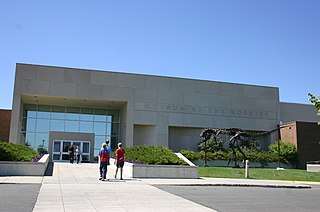
Museum of the Rockies is a museum in Bozeman, Montana. Originally affiliated with Montana State University in Bozeman, and now also, the Smithsonian Institution. The museum is largely known for its Paleontological collections as well as having the largest collection of North American Dinosaur fossils in the United States. They also possess the largest Tyrannosaurus skull ever discovered, as well as the thigh bone of a Tyrannosaurus rex that contains soft-tissue remains. The museum is part of the Montana Dinosaur Trail and is Montana's official repository for Paleontological specimens.

Astrodon is a genus of large herbivorous sauropod dinosaur, measuring 20 m (66 ft) in length, 9 m (30 ft) in height and 20 metric tons in body mass. It lived in what is now the eastern United States during the Early Cretaceous period, and fossils have been found in the Arundel Formation, which has been dated through palynomorphs to the Albian about 112 to 110 million years ago.

Charles Whitney Gilmore was an American paleontologist who gained renown in the early 20th century for his work on vertebrate fossils during his career at the United States National Museum. Gilmore named many dinosaurs in North America and Mongolia, including the Cretaceous sauropod Alamosaurus, Alectrosaurus, Archaeornithomimus, Bactrosaurus, Brachyceratops, Chirostenotes, Mongolosaurus, Parrosaurus, Pinacosaurus, Styracosaurus ovatus and Thescelosaurus.

Sue is the nickname given to FMNH PR 2081, which is one of the largest, most extensive, and best preserved Tyrannosaurus rex specimens ever found, at over 90 percent recovered by bulk. FMNH PR 2081 was discovered on August 12, 1990, by American explorer and fossil collector Sue Hendrickson, and was named after her.

Tyrannosaurus is one of the most iconic dinosaurs and is known from numerous specimens, some of which have individually acquired notability due to their scientific significance and media coverage.
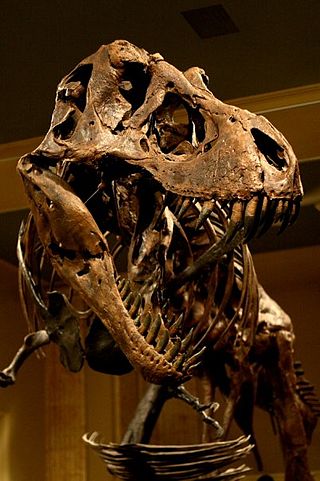
The Dinosaur Discovery Museum in Kenosha, Wisconsin, United States, is dedicated to the exploration and explication of the relationship between modern birds and ancient carnivorous biped dinosaurs, the theropods, which include Carnotaurus, Tyrannosaurus rex, and Archaeopteryx. This link is especially well documented in the fossil record. The museum has the largest skeletal cast collection of theropods (meat-eating) dinosaurs in North America and is the only museum to focus a gallery specifically on the evolution of birds from non-avian dinosaurs, with a second smaller gallery focusing on "Little Clint", a three-year-old Tyrannosaurus uncovered by a dig conducted with the Carthage Institute of Paleontology.

Dinosaur Park is a park located in the 13200 block of Mid-Atlantic Boulevard, near Laurel and Muirkirk, Maryland, and operated by the Prince George's County Department of Parks and Recreation. The park features a fenced area where visitors can join paleontologists and volunteers in searching for early Cretaceous fossils. The park also has an interpretive garden with plants and information signs. The park is in the approximate location of discoveries of Astrodon teeth and bones as early as the 19th century.
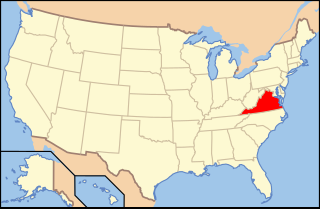
Paleontology in Virginia refers to paleontological research occurring within or conducted by people from the U.S. state of Virginia. The geologic column in Virginia spans from the Cambrian to the Quaternary. During the early part of the Paleozoic, Virginia was covered by a warm shallow sea. This sea would come to be inhabited by creatures like brachiopods, bryozoans, corals, and nautiloids. The state was briefly out of the sea during the Ordovician, but by the Silurian it was once again submerged. During this second period of inundation the state was home to brachiopods, trilobites and entire reef systems. During the mid-to-late Carboniferous the state gradually became a swampy environment.
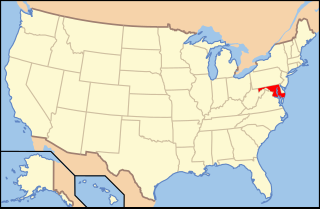
Paleontology in Maryland refers to paleontological research occurring within or conducted by people from the U.S. state of Maryland. The invertebrate fossils of Maryland are similar to those of neighboring Delaware. For most of the early Paleozoic era, Maryland was covered by a shallow sea, although it was above sea level for portions of the Ordovician and Devonian. The ancient marine life of Maryland included brachiopods and bryozoans while horsetails and scale trees grew on land. By the end of the era, the sea had left the state completely. In the early Mesozoic, Pangaea was splitting up. The same geologic forces that divided the supercontinent formed massive lakes. Dinosaur footprints were preserved along their shores. During the Cretaceous, the state was home to dinosaurs. During the early part of the Cenozoic era, the state was alternatingly submerged by sea water or exposed. During the Ice Age, mastodons lived in the state.

Paleontology in Pennsylvania refers to paleontological research occurring within or conducted by people from the U.S. state of Pennsylvania. The geologic column of Pennsylvania spans from the Precambrian to Quaternary. During the early part of the Paleozoic, Pennsylvania was submerged by a warm, shallow sea. This sea would come to be inhabited by creatures like brachiopods, bryozoans, crinoids, graptolites, and trilobites. The armored fish Palaeaspis appeared during the Silurian. By the Devonian the state was home to other kinds of fishes. On land, some of the world's oldest tetrapods left behind footprints that would later fossilize. Some of Pennsylvania's most important fossil finds were made in the state's Devonian rocks. Carboniferous Pennsylvania was a swampy environment covered by a wide variety of plants. The latter half of the period was called the Pennsylvanian in honor of the state's rich contemporary rock record. By the end of the Paleozoic the state was no longer so swampy. During the Mesozoic the state was home to dinosaurs and other kinds of reptiles, who left behind fossil footprints. Little is known about the early to mid Cenozoic of Pennsylvania, but during the Ice Age it seemed to have a tundra-like environment. Local Delaware people used to smoke mixtures of fossil bones and tobacco for good luck and to have wishes granted. By the late 1800s Pennsylvania was the site of formal scientific investigation of fossils. Around this time Hadrosaurus foulkii of neighboring New Jersey became the first mounted dinosaur skeleton exhibit at the Academy of Natural Sciences in Philadelphia. The Devonian trilobite Phacops rana is the Pennsylvania state fossil.
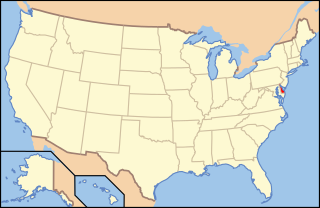
Paleontology in Delaware refers to paleontological research occurring within or conducted by people from the U.S. state of Delaware. There are no local rocks of Precambrian, Paleozoic, Triassic, or Jurassic age, so Delaware's fossil record does not begin until the Cretaceous period. As the Early Cretaceous gave way to the Late Cretaceous, Delaware was being gradually submerged by the sea. Local marine life included cephalopods like Belemnitella americana, and marine reptiles. The dwindling local terrestrial environments were home to a variety of plants, dinosaurs, and pterosaurs. Along with New Jersey, Delaware is one of the best sources of Late Cretaceous dinosaur fossils in the eastern United States. Delaware was still mostly covered by sea water through the Cenozoic era. Local marine life included manatees, porpoises, seals, and whales. Delaware was worked over by glaciers during the Ice Age. The Cretaceous belemnite Belemnitella americana is the Delaware state fossil.
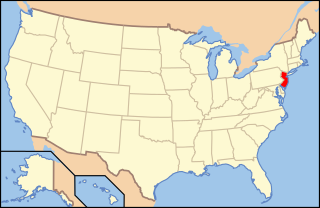
Paleontology in New Jersey refers to paleontological research in the U.S. state of New Jersey. The state is especially rich in marine deposits.

Paleontology in Massachusetts refers to paleontological research occurring within or conducted by people from the U.S. state of Massachusetts. The fossil record of Massachusetts is very similar to that of neighboring Connecticut. During the early part of the Paleozoic era, Massachusetts was covered by a warm shallow sea, where brachiopods and trilobites would come to live. No Carboniferous or Permian fossils are known from the state. During the Cretaceous period the area now occupied by the Elizabeth Islands and Martha's Vineyard were a coastal plain vegetated by flowers and pine trees at the edge of a shallow sea. No rocks are known of Paleogene or early Neogene age in the state, but during the Pleistocene evidence indicates that the state was subject to glacial activity and home to mastodons. The local fossil theropod footprints of Massachusetts may have been at least a partial inspiration for the Tuscarora legend of the Mosquito Monster or Great Mosquito in New York. Local fossils had already caught the attention of scientists by 1802 when dinosaur footprints were discovered in the state. Other notable discoveries include some of the first known fossil of primitive sauropodomorphs and Podokesaurus. Dinosaur tracks are the Massachusetts state fossil.

Paleontology in the United States refers to paleontological research occurring within or conducted by people from the United States. Paleontologists have found that at the start of the Paleozoic era, what is now "North" America was actually in the southern hemisphere. Marine life flourished in the country's many seas. Later the seas were largely replaced by swamps, home to amphibians and early reptiles. When the continents had assembled into Pangaea drier conditions prevailed. The evolutionary precursors to mammals dominated the country until a mass extinction event ended their reign.
The geological history of North America comprises the history of geological occurrences and emergence of life in North America during the interval of time spanning from the formation of the Earth through to the emergence of humanity and the start of prehistory. At the start of the Paleozoic Era, what is now "North" America was actually in the Southern Hemisphere. Marine life flourished in the country's many seas, although terrestrial life had not yet evolved. During the latter part of the Paleozoic, seas were largely replaced by swamps home to amphibians and early reptiles. When the continents had assembled into Pangaea, drier conditions prevailed. The evolutionary precursors to mammals dominated the country until a mass extinction event ended their reign.

Paleontology in the United States can first be traced to the Native Americans, who have been familiar with fossils for thousands of years. They both told myths about them and applied them to practical purposes. African slaves also contributed their knowledge; the first reasonably accurate recorded identification of vertebrate fossils in the new world was made by slaves on a South Carolina plantation who recognized the elephant affinities of mammoth molars uncovered there in 1725. The first major fossil discovery to attract the attention of formally trained scientists were the Ice Age fossils of Kentucky's Big Bone Lick. These fossils were studied by eminent intellectuals like France's George Cuvier and local statesmen and frontiersman like Daniel Boone, Benjamin Franklin, William Henry Harrison, Thomas Jefferson, and George Washington. By the end of the 18th century possible dinosaur fossils had already been found.

This timeline of tyrannosaur research is a chronological listing of events in the history of paleontology focused on the tyrannosaurs, a group of predatory theropod dinosaurs that began as small, long-armed bird-like creatures with elaborate cranial ornamentation but achieved apex predator status during the Late Cretaceous as their arms shrank and body size expanded. Although formally trained scientists did not begin to study tyrannosaur fossils until the mid-19th century, these remains may have been discovered by Native Americans and interpreted through a mythological lens. The Montana Crow tradition about thunder birds with two claws on their feet may have been inspired by isolated tyrannosaurid forelimbs found locally. Other legends possibly inspired by tyrannosaur remains include Cheyenne stories about a mythical creature called the Ahke, and Delaware stories about smoking the bones of ancient monsters to have wishes granted.



















